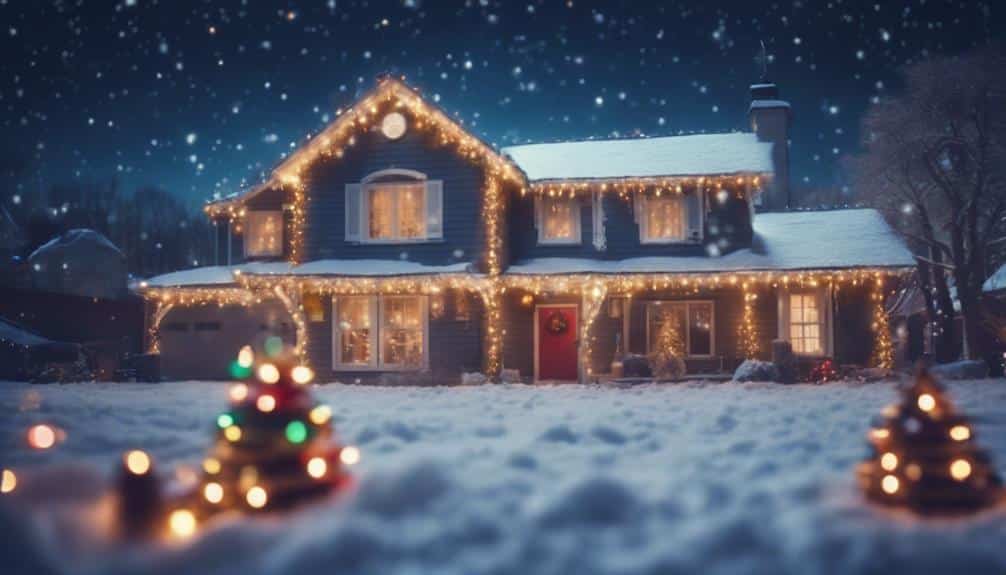
The Best Power Sources for Your Outdoor Christmas Light Display
When choosing power sources for your outdoor Christmas light display, you’ve got several options. Traditional plug-in power remains popular, utilizing standard 120-volt AC outlets and outdoor-rated extension cords. Solar-powered lights offer an eco-friendly alternative, converting sunlight into electricity for LED bulbs. Battery-operated solutions provide versatility with various types available. Smart power management systems optimize energy consumption through programmable timers and remote control. For energy efficiency, consider LED lights, fiber optics, or laser projectors. Each option has its pros and cons, influenced by factors like installation complexity, energy costs, and environmental impact. Exploring these power sources in detail will help you make an informed decision for your festive display.
Traditional Plug-In Power Options
For traditional outdoor Christmas light displays, standard 120-volt AC power from household electrical outlets serves as the primary energy source. You’ll typically connect your lights to these outlets using extension cords rated for outdoor use. It’s essential to select cords with the appropriate amperage capacity to handle your display’s power requirements.
When planning your layout, you’ll need to take into account the number and location of available outdoor outlets. Most residential properties have limited exterior power points, often requiring strategic placement of power distribution boxes or weatherproof outlet strips. These devices allow you to expand a single outlet into multiple connection points.
You must also consider voltage drop, which occurs as electricity travels along long cord runs. This phenomenon can cause lights at the end of a string to appear dimmer. To address this issue, you can use thicker gauge wires for extended runs or implement a parallel wiring configuration.
Safety is paramount when using plug-in power. Always use Ground Fault Circuit Interrupter (GFCI) protected outlets to prevent electric shock hazards. Additionally, make sure all connections are weatherproofed using appropriate outdoor-rated junction boxes or waterproof cord covers to protect against moisture intrusion and potential short circuits.
Solar-Powered Christmas Lights
In contrast to traditional plug-in options, solar-powered Christmas lights offer an eco-friendly and energy-efficient alternative for outdoor holiday displays. These lights harness solar energy through photovoltaic panels, converting sunlight into electricity to power LED bulbs. The system typically consists of a solar panel, rechargeable batteries, and an array of LED lights.
During daylight hours, the solar panel charges the batteries, which then power the lights at night. Most models feature automatic on/off switches triggered by ambient light levels. You’ll find various designs, including string lights, icicle lights, and pathway markers, all powered by solar technology.
The primary advantages of solar-powered Christmas lights include reduced energy costs, simplified installation without the need for electrical outlets, and increased flexibility in placement. However, their performance depends on factors such as sunlight exposure and battery capacity. In areas with limited winter sunlight, you may experience shorter illumination periods or reduced brightness.
When selecting solar-powered Christmas lights, consider factors like battery life, light output, and weatherproofing. Higher-quality models often feature more efficient solar panels and longer-lasting batteries, ensuring better performance throughout the holiday season.
Battery-Operated Outdoor Lighting Solutions
Battery-operated outdoor lighting solutions offer a versatile alternative to both traditional plug-in and solar-powered Christmas lights, providing flexibility in placement and installation without reliance on sunlight or proximity to electrical outlets. These systems typically utilize LED bulbs, which consume minimal power, allowing for extended operation on a single set of batteries.
You’ll find various battery types employed, including AA, C, D, and even rechargeable lithium-ion packs.
When selecting battery-operated lights, consider the battery life, which can range from 20 to 150 hours depending on the model and settings. Many units feature built-in timers and multiple lighting modes, enabling you to customize your display while conserving power. Weather resistance is essential for outdoor use, so look for IP-rated enclosures to protect the battery compartments from moisture and debris.
One drawback of battery-powered systems is the need for periodic battery replacement or recharging. However, this inconvenience is often outweighed by the freedom to illuminate areas far from power sources.
Some advanced models even incorporate small solar panels to trickle-charge the batteries, combining the benefits of both power sources and extending operational time.
Smart Power Management Systems
Smart power management systems revolutionize outdoor Christmas lighting by integrating advanced technologies that optimize energy consumption, enhance control, and improve overall efficiency. These systems incorporate intelligent features that allow you to monitor and adjust your outdoor lighting setup with unprecedented precision.
Key components of smart power management systems include:
- Programmable timers with astronomical clock functions
- Remote control capabilities via smartphone apps
- Energy monitoring and usage analytics
You’ll find that these systems offer granular control over your outdoor lighting display. They enable you to set specific on/off schedules, adjusting for seasonal changes in daylight hours automatically.
You can also create custom lighting zones, allowing for differentiated control of various sections of your display. Smart power management systems often integrate with home automation platforms, providing seamless coordination with other smart home devices.
This integration allows for advanced features such as voice control and geofencing, which can trigger your lights based on your proximity to home.
Energy-Efficient Alternatives
While traditional incandescent bulbs have long dominated outdoor Christmas displays, energy-efficient alternatives now offer you substantial power savings without compromising on festive ambiance. LED lights stand out as the most popular choice, consuming up to 80% less energy than incandescent bulbs. They’re also more durable, lasting up to 25 times longer, which reduces replacement costs.
Fiber optic lights present another energy-efficient option. These utilize a single light source to illuminate multiple strands, greatly reducing power consumption. Solar-powered lights harness renewable energy, eliminating electricity costs entirely. However, their performance depends on sunlight exposure and battery capacity.
Laser projectors offer a high-impact, low-energy alternative. These devices project thousands of light points onto surfaces, creating expansive displays with minimal power use. Electroluminescent wire (EL wire) provides a unique, energy-efficient lighting option. It consumes little power and offers flexibility in design.
When selecting energy-efficient alternatives, consider factors such as color rendering index (CRI), lumen output, and color temperature. These metrics ensure your chosen lights provide the desired visual effect while maximizing energy savings.
Frequently Asked Questions
How Do I Calculate the Total Wattage Needed for My Outdoor Christmas Display?
To calculate the total wattage needed for your outdoor Christmas display, you’ll need to take inventory of all your lights and decorations. Check each item’s wattage rating, usually found on the packaging or product label.
Add up these individual wattages to get your total. Don’t overlook any inflatable decorations or motorized elements.
It’s prudent to include a 10-20% buffer for safety. This calculation guarantees you’ll have sufficient power and helps prevent overloading your electrical circuits.
Can I Use Indoor Christmas Lights for Outdoor Decorations?
You’d be making a catastrophic mistake using indoor lights outdoors! While it’s tempting, indoor Christmas lights aren’t designed to withstand the elements. They lack the necessary weatherproofing and insulation for outdoor use. You’ll risk electrical shorts, fire hazards, and premature failure.
Always opt for lights specifically labeled for outdoor use. These feature enhanced insulation, sealed connections, and UV-resistant materials. Outdoor-rated lights also often have thicker wires and more durable bulbs to withstand temperature fluctuations and precipitation.
Prioritize safety and longevity in your outdoor holiday display.
What Safety Precautions Should I Take When Installing Outdoor Christmas Lights?
When installing outdoor Christmas lights, prioritize safety. Confirm all lights and extension cords are rated for outdoor use. Inspect wires for damage before use.
Use a ground fault circuit interrupter (GFCI) outlet to prevent electrical shocks. Secure lights properly to avoid wind damage. Don’t overload circuits; follow manufacturer’s guidelines.
Keep connections dry and elevated. Turn off lights when leaving or sleeping. Use a timer for automatic shut-off. Always follow local electrical codes and regulations.
How Do I Troubleshoot Flickering or Partially Lit Outdoor Christmas Light Strings?
To troubleshoot flickering or partially lit outdoor Christmas light strings, first check for loose bulbs and tighten them. Replace any burnt-out bulbs, as these can disrupt the circuit.
Inspect the wiring for damage or exposed areas. Test the fuse in the plug and replace if necessary. If using LED lights, make sure your dimmer switch is compatible.
Check connections between light strings and power sources. If problems persist, consider using a multimeter to identify voltage issues or faulty sections in the string.
Are There Any Local Regulations or HOA Rules Regarding Outdoor Christmas Light Displays?
Imagine twinkling lights cascading down your home’s facade, illuminating the winter night. Before you create this dazzling display, it’s essential to check local regulations and HOA rules.
Many areas have specific guidelines on holiday lighting, including duration, brightness, and hours of operation. You’ll need to research your municipality’s ordinances and review your HOA’s bylaws.
Some restrictions might limit the size of displays, prohibit certain types of lights, or require permits for extensive setups. Compliance guarantees a festive, neighbor-friendly showcase.
Conclusion
You’ve explored traditional and innovative power sources for your outdoor Christmas display.
While plug-in options offer reliability, solar and battery-operated lights provide flexibility.
Smart systems enhance control, juxtaposing convenience with energy efficiency.
As you weigh luminosity against power consumption, consider the long-term environmental impact of your choices.
Your decision will illuminate not just your home, but also your commitment to sustainable festivities.
Analyze each option’s technical specifications to optimize your display’s performance and energy footprint.
